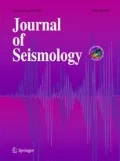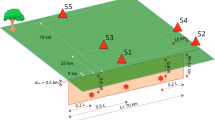Abstract
A recently compiled, comprehensive, and good-quality strong-motion database of the Iranian earthquakes has been used to develop local empirical equations for the prediction of peak ground acceleration (PGA) and 5%-damped pseudo-spectral accelerations (PSA) up to 4.0 s. The equations account for style of faulting and four site classes and use the horizontal distance from the surface projection of the rupture plane as a distance measure. The model predicts the geometric mean of horizontal components and the vertical-to-horizontal ratio. A total of 1551 free-field acceleration time histories recorded at distances of up to 200 km from 200 shallow earthquakes (depth < 30 km) with moment magnitudes ranging from Mw 4.0 to 7.3 are used to perform regression analysis using the random effects algorithm of Abrahamson and Youngs (Bull Seism Soc Am 82:505–510, 1992), which considers between-events as well as within-events errors. Due to the limited data used in the development of previous Iranian ground motion prediction equations (GMPEs) and strong trade-offs between different terms of GMPEs, it is likely that the previously determined models might have less precision on their coefficients in comparison to the current study. The richer database of the current study allows improving on prior works by considering additional variables that could not previously be adequately constrained. Here, a functional form used by Boore and Atkinson (Earthquake Spect 24:99–138, 2008) and Bindi et al. (Bull Seism Soc Am 9:1899–1920, 2011) has been adopted that allows accounting for the saturation of ground motions at close distances. A regression has been also performed for the V/H in order to retrieve vertical components by scaling horizontal spectra. In order to take into account epistemic uncertainty, the new model can be used along with other appropriate GMPEs through a logic tree framework for seismic hazard assessment in Iran and Middle East region.

















Similar content being viewed by others
References
Abrahamson NA, Youngs RR (1992) A stable algorithm for regression analysis using the random effects model. Bull Seism Soc Am 82:505–510
Akkar S, Bommer JJ (2010) Empirical equations for the prediction of PGA, PGV and spectral accelerations in Europe, the Mediterranean Region and the Middle East. Seism Res Lett 81:195–206
Akkar S, Cagnan Z (2010) A local ground-motion predictive model for Turkey, and its comparison with other regional and global ground-motion models. Bull Seismol Soc Am 100:2978–2995
Akkar S, Sandıkkaya MA, Bommer JJ (2014) Empirical ground-motion models for point-and extended-source crustal earthquake scenarios in Europe and the Middle East. Bull Earthq Eng 12:359–387
Al Atik L, Abrahamson N, Bommer JJ, Scherbaum F, Cotton F, Kuehn N (2010) The variability of ground-motion prediction models and its components. Seismol Res Lett 81:794–801
Ambraseys NN, Douglas J, Sarma SK, Smit PM (2005) Equations for the estimation of strong ground motion from shallow crustal earthquakes using data from Europe and the Middle East: horizontal peak ground acceleration and spectral acceleration. Bull Earthq Eng 3:1–53
Ansari A, Noorzad A, Zafarani H, Vahidifard H (2010) Correction of highly noisy strong motion records using a modified wavelet de-noising method. Soil Dyn Earthq Eng 30:1168–1181
Berberian M (1976) Contribution to the seismotectonics of Iran (Part 2). Geological Survey of Iran Report 39 518pp
Berberian M, Qorashi M, Jackson JA, Priestley K, Wallace T (1992) The Rudbar-Tarom earthquake of 20 June 1990 in NW Persia: preliminary field and seismological observations, and its tectonic significance. Bull Seism Soc Am 82:1726–1755
Beyer K, Bommer JJ (2006) Relationships between median values and between aleatory variabilities for different definitions of the horizontal component of motion. Bull Seism Soc Am 96:1512–1522
Bindi D, Pacor F, Luzi L, Puglia R, Massa M, Ameri G, Paolucci R (2011) Ground motion prediction equations derived from the Italian strong motion database. Bull Seism Soc Am 9:1899–1920
Bindi D, Massa M, Luzi L, Ameri G, Pacor F, Puglia R, Augliera P (2014) Pan-European ground-motion prediction equations for the average horizontal component of PGA, PGV, and 5%-damped PSA at spectral periods up to 3.0 s using the RESORCE dataset. Bull Earthq Eng 12:391–430
Bommer JJ, Douglas J, Scherbaum F, Cotton F, Bungum H, Fah D (2010) On the selection of ground-motion prediction equations for seismic hazard analysis. Seism Res Lett 81:783–793
Bommer JJ, Akkar S, Kale O (2011) A model for vertical-to-horizontal response spectral ratios for Europe and the Middle East. Bull Seism Soc Am 101:1783–1806
Boore DM, Atkinson G (2008) Ground motion prediction equations for the average horizontal component of PGA, PGV, and 5%-damped PSA at spectral periods between 0.01 s and 10.0 s. Earthquake Spect 24:99–138
Boore DM, Stewart JP, Seyhan E, Atkinson GM (2014) NGA-West2 equations for predicting PGA, PGV, and 5% damped PSA for shallow crustal earthquakes. Earthq Spectra 30(3):1057–1085
Bozorgnia Y, Campbell KW (2004) The vertical-to-horizontal response spectral ratio and tentative procedures for developing simplified V/H and vertical design spectra. J Earthq Eng 8:175–207
Budnitz RJ, Apostolakis G, Boore DM, Cluff LS, Coppersmith K, Cornell CA, Morris BJ (1997) Recommendations for probabilistic seismic hazard analysis, in guidance on uncertainty and use of experts. Lawrence Livermore National Laboratory, Vol. 2. US Nuclear Regulatory Commission, Rockville, MD
Cotton F, Scherbaum F, Bommer JJ, Bungum H (2006) Criteria for selecting and adjusting ground-motion models for specific target applications: applications to Central Europe and rock sites. J Seismol 10:137–156
Delavaud E, Scherbaum F, Kuehn N, Allen T (2012) Testing the global applicability of ground-motion prediction equations for active shallow crustal regions. Bull Seismol Soc Am 102:707–721
Douglas J (2011) Ground-motion prediction equations 1964–2010, Final Rept. RP-59356-FR, Bureau de Recherches Géologiques et Minières (BRGM), Orléans, France, 444 pp.
European Committee for Standardization, CEN (2003) Eurocode 8: design of structures for earthquake resistance—part 1: general rules, seismic actions and rules for buildings, EN-1998-1: 2003. European Committee for Standardization, Brussels
Ghasemi H, Zare M, Fukushima Y, Koketsu K (2009a) An empirical spectral ground-motion model for Iran. J Seismol 13:499–515
Ghasemi H, Zare M, Fukushima Y, Sinaeian F (2009b) Applying empirical methods in site classification, using response spectral ratio (H/V): a case study on Iranian strong motion network (ISMN). Soil Dyn Earthq Eng 29:121–132
Gregor N, Abrahamson NA, Atkinson GM, Boore DM, Bozorgnia Y, Campbell KW et al (2014) Comparison of NGA-West2 GMPEs. Earthq Spec 30(3):1179–1197
Halldorsson B, Papageorgiou AS (2005) Calibration of the specific barrier model to earthquakes of different tectonic regions. Bull Seis Soc Am 95:1276–1300
Jahanandish M, Zafarani H, Shafiee AH (2017) Implementation of the square-root-impedance method to estimate site amplification in Iran using random profile generation. Bull Seis Soc Am 107:456–467
Kaklamanos J, Baise LG, Boore DM (2011) Estimating unknown input parameters when implementing the NGA groundmotion prediction equations in engineering practice. Earthq Spectra 27:1219–1235
Kaklamanos J, Bradley BA, Thompson EM, Baise LG (2013) Critical parameters affecting bias and variability in site-response analyses using KiK-net downhole array data. Bul Seisl Soc Am 103:1733–1749
Kale Ö, Akkar S, Ansari A, Hamzehloo H (2015) A ground-motion predictive model for Iran and Turkey for horizontal PGA, PGV, and 5%-damped response spectrum: investigation of possible regional effects. Bull Seismol Soc Am 105:963–980
Khodaverdian A, Zafarani H, Rahimain M (2015) Long term fault slip rates, distributed deformation rates and forecast of seismicity in the Iranian Plateau. Tectonics 34:2190–2220
McGuire RK (1978) Frisk: computer program for seismic risk analysis using faults as earthquake sources. United States Department of the Interior, Geological Survey, Open-File Report, 78–107
Mirzaei N, Gao M, Chen YT (1998) Seismic source regionalization for seismic zoning of Iran: major seismotectonic Provinces. Journal of Earthquake Prediction Research 7:465–495
Mousavi M, Zafarani H, Noorzad A, Ansari A, Bargi K (2007) Analysis of Iranian strong-motion data using the specific barrier model. J Geophys Eng 4:415–428
Mousavi M, Zafarani H, Rahpeyma S, Azarbakht A (2014) Test of goodness of the NGA ground-motion equations to predict the strong motions of the 2012 Ahar-Varzaghan dual earthquakes in northwestern Iran. Bull Seism Soc Am 104:2512–2528
Mousavi M, Ansari A, Zafarani H, Azarbakht A (2012) Selection of ground motion prediction models for seismic hazard analysis in the Zagros Region, Iran. J Earthq Eng 16:1184–1207
Musson RMW (2009) Ground motion and probabilistic hazard. Bull Earthq Eng 7:575–589
Niazi M, Bozorgnia Y (1992) The 1990 Manjil, Iran, earthquake: geology and seismology overview, PGA attenuation, and observed damage. Bull Seismol Soc Am 82:774–799
Nowroozi AA (1976) Seismotectonic provinces of Iran. Bull Seismol Soc Am 66:1249–1276
Power M, Chiou B, Abrahamson N, Bozorgnia Y, Shantz T, Roblee C (2008) An overview of the NGA project. Earthq Spect 24:3–21
Saffari H, Kuwata Y, Takada S, Mahdavian A (2012) Updated PGA, PGV, and spectral acceleration attenuation relations for Iran. Earthq Spect 28:257–276
Scasserra G, Stewart JP, Bazzurro P, Lanzo G, Mollaioli F (2009) A comparison of NGA ground-motion prediction equations to Italian data. Bull Seismol Soc Am 99:2961–2978
Shahvar MP, Zare M, Castellaro S (2013) A unified seismic catalog for the Iranian plateau (1900–2011). Seismol Res Lett 84:233–249
Scherbaum F, Cotton F, Smit P (2004) On the use of response spectral-reference data for the selection and ranking of ground motion models for seismic-hazard analysis in regions of moderate seismicity: the case of rock motion. Bull Seismol Soc Am 94(6):2164–2185
Scherbaum F, Delavaud E, Riggelsen C (2009) Model selection in seismic hazard analysis: an information-theoretic perspective. Bull Seismol Soc Am 99(6):3234–3247
Shoja-Taheri J, Anderson JG (1988) The 1978 Tabas, Iran, earthquake: an interpretation of the strong-motion records. Bull Seismol Soc Am 78:142–171
Soghrat MR, Khaji N, Zafarani H (2012) Simulation of strong ground motion in northern Iran using the specific barrier model. Geophys J Int 188:645–679
Soghrat MR, Ziyaeifar M (2016) A predictive equation for vertical-to-horizontal response spectral ratios in Northern Iran. Bull Seis Soc Am 106:123–140
Takin M (1972) Iranian geology and continental drift in the Middle East. Nature 235:147–150
Trifunac MD, Lee VW (1973) Routine computer processing of strong motion accelerograms. Report EERL 73-03, Calif. Inst. of Tech., Pasadena, California
Zafarani H, Mousavi M, Noorzad A, Ansari A (2008) Calibration of the specific barrier model to Iranian plateau earthquakes and development of physically based attenuation relationships for Iran. Soil Dyn Earthq Eng 28:550–576
Zafarani H, Farhadi A (2017) Testing ground-motion prediction equations against small-to-moderate magnitude data in Iran. Bull Seismol Soc Am 107:912–933
Zafarani H, Soghrat MR (2017a) A selected dataset of the Iranian strong motion records. Nat Hazards 86:1307–1332
Zafarani H, Soghrat MR (2017b) Single-station sigma for the Iranian strong-motion stations. Pure Appl Geophys. https://doi.org/10.1007/s00024-017-1613-z
Zafarani H, Hassani B (2013) Site response and source spectra of S-waves in the Zagros region, Iran. J Seismol 17:645–666
Zafarani H, Mousavi M (2014) Applicability of different ground-motion prediction models for northern Iran. Nat Hazards 73:1199–1228
Zafarani H, Soghrat MR (2012) Simulation of ground motion in the Zagros region, Iran using the specific barrier model and stochastic method. Bull Seism Soc Am 102:2031–2045
Zafarani H, Hassani B, Ansari A (2012) Estimation of earthquake parameters in the Alborz seismic zone, Iran using generalized inversion method. Soil Dyn Earthq Eng 42:197–218
Zare M, Bard PY, Ghafory-Ashtiany M (1999) Site characterizations for the Iranian strong motion network. Soil Dyn Earthq Eng 18:101–123
Acknowledgements
The authors acknowledge the Building and Housing Research Centre of Iran for providing them with the accelerograms and shear wave velocities used in the current study. H. Zafarani and M.R. Soghrat were supported by the International Institute of Earthquake Engineering and Seismology (IIEES) funds. This work has been also supported by the Iran National Science Foundation (INSF).
Author information
Authors and Affiliations
Corresponding author
Appendix
Appendix
Rights and permissions
About this article
Cite this article
Zafarani, H., Luzi, L., Lanzano, G. et al. Empirical equations for the prediction of PGA and pseudo spectral accelerations using Iranian strong-motion data. J Seismol 22, 263–285 (2018). https://doi.org/10.1007/s10950-017-9704-y
Received:
Accepted:
Published:
Issue Date:
DOI: https://doi.org/10.1007/s10950-017-9704-y




